#Music of Ghana Origin
Explore tagged Tumblr posts
Text




#moliy#afrobeats#afrofusion#music#wondergang#wondergirl#ghana girl#ghana#original character#nyc#afropunk#afro#afrofuturism#afro latina#afro sexy#african beauty#melanin#afro hair#african#afrocentric#BRAIDS#itty bitty waist pretty face#slim waist#curvy#just dance#dance#dance music#pop
25 notes
·
View notes
Text
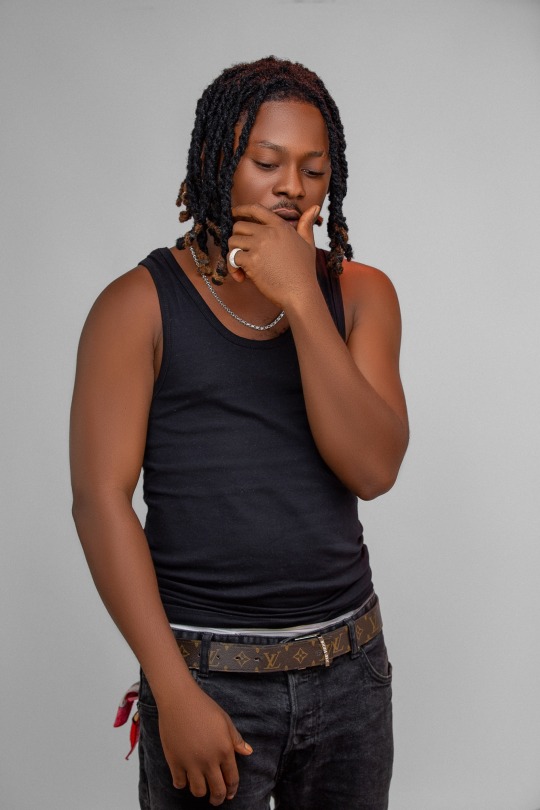
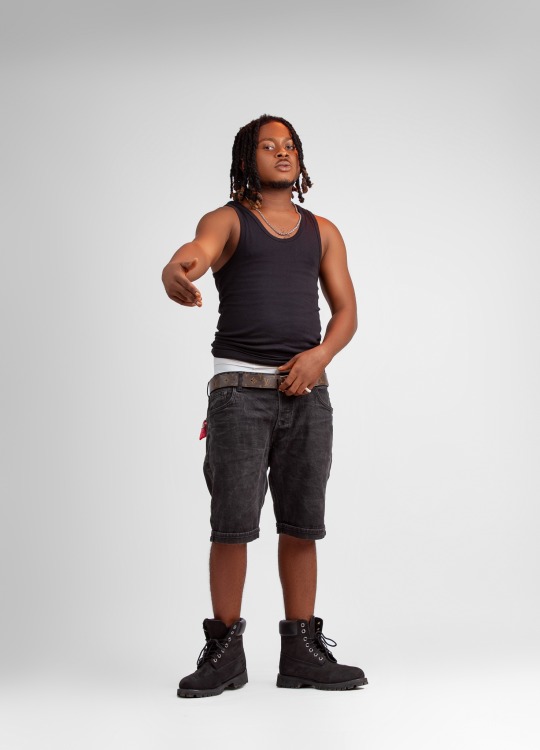
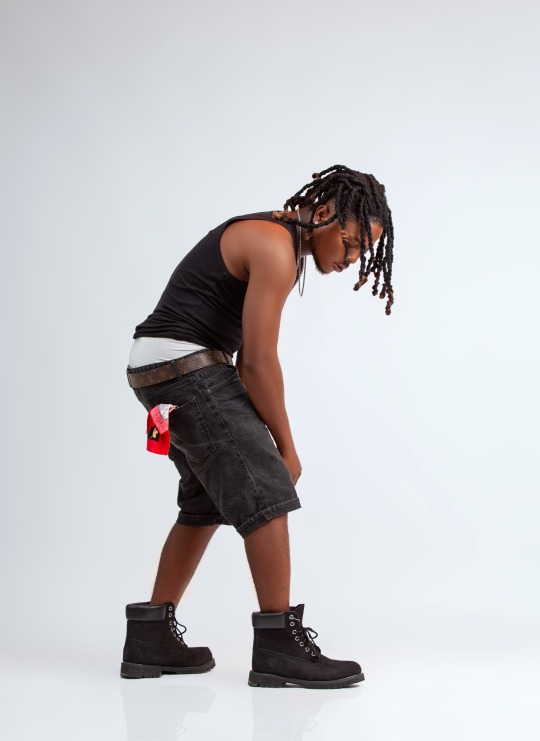

Hey fam
I have a brand new song to be released
Titled: Nacking 😄
#elon musk#halloween#asexual#the witcher#miraculous ladybug#interview with the vampire#house of the dragon#doctor who#spy x family#tales of the jedi#ghana music#ghanarepublicday#ghana news#original music#dancehall#dj kahled#rick ross
4 notes
·
View notes
Text
youtube
Woya or Woyaya - To go on (a journey). Here is the origin of the word, voyage.
There is a reason, the English language is called Poto Kasa by our ancestors. The blended language. Composed from already existing languages.
#music#osibisa#akan institute#journey#voyage#explore#the origins of language#origins of words#age of exploration#ghana#Youtube
0 notes
Text
I want to take the time to remember the late Isaac Hayes, soul music singer, songwriter, musician, arranger, score composer, actor, and of course the voice of Chef, who would have turned 82 yesterday.
Where do I even begin with this man? One of the principal songwriters, musicians, and producers for so much of Stax Records' heyday, co-writing several hits for the likes of Sam & Dave with Dave Porter as well as contributing organ, piano, saxophone, and horn arrangements to several records and becoming a critical figure in Southern soul in the process.
He would then went on to cut solo records of his own like Hot Buttered Soul, Black Moses, and the soundtracks for films like Shaft and Tough Guys, on top of headlining the iconic Wattstax Festival. In a time when soul music was largely driven by the three to four minute singles to crossover to the pop charts, Isaac crafted soul epics that demanded the listener's attention. Rather it be through originals or reinterpretations of others' songs, any song Isaac sang was instantly his. Besides pioneering progressive soul, Isaac would also foreshadow the rise of hip hop with his series of monologues known as "Ike's Rap".
Having grown up in poverty and having been friends with people such as Dr. King, Isaac always sought to not only deliver words of empowerment for black people but also make the world a better place. As the co-founder of the Black Knights, Isaac helped fight police brutality and discrimination, and would also establish food banks within Memphis and help black voters get registered. He would also establish the Isaac Hayes Foundation in 1999 to assist vulnerable populations in realizing their fullest potential in areas such as health care, economics, and environmental and human development. As an Ambassador for the World Literacy Crusade, Isaac would be crowned an honorary king of Ghana's Ada district for his work in supporting literacy. It was also in Ghana that Isaac opened a school designed to link African children with those in American inner cities through the internet.
So when two guys in Colorado were creating a show and came up with the idea of a soul singing school cafeteria chef, Isaac ended up being just what the doctor ordered. Beyond the credibility of having an actual soul singer voice the character, Isaac gave Chef so much more beyond that. Rather it be the wacky, surreal Kid's-Show-Gone-Amok or the greater emphasis on social commentary, Chef provided a strong anchor to the madness that surrounded him. He was the rock that the boys could always fall back on, the confidant when things go awry. Through Isaac, Chef had humor, joy, warmth, conviction, and ultimately, love. And that is both of their greatest legacies above all else.


#chef south park#jerome mcelroy#isaac hayes#soul#soul music#stax records#shaft#sam and dave#Spotify#chef aid
10 notes
·
View notes
Text
large sum of cash gold bars and counterfeit money found in Ghana
3 notes
·
View notes
Text

Erykah Badu Posing for her High School Senior Picture in 1989.
The Photo at the very bottom was also Taken in 1989.
Erica Abi Wright (born February 26, 1971), known professionally as Erykah Badu, is an American singer and songwriter. Influenced by R&B, soul, and hip hop, Badu rose to prominence in the late 1990s when her debut album Baduizm (1997), placed her at the forefront of the neo soul movement, earning her the nickname "Queen of Neo Soul" by music critics.
Erykah Badu was born in Dallas, Texas. Badu had her first taste of show business at the age of four, singing and dancing at the Dallas Theater Center and The Black Academy of Arts and Letters (TBAAL) under the guidance of her godmother, Gwen Hargrove, and uncle TBAAL founder Curtis King. By the age of 14, Badu was freestyling for a local radio station alongside such talent as Roy Hargrove. In her youth, she had decided to change the spelling of her first name from Erica to Erykah, as she believed her original name was a "slave name". The term "kah" signifies the inner self. She adopted the surname "Badu" because it is her favorite jazz scat sound; also, among the Akan people in Ghana, it is the term for the 10th-born child.
After graduating from Booker T. Washington High School for the Performing and Visual Arts, Badu went on to study theater at Grambling State University, a historically black university. She left the university in 1993 before graduating, to focus more fully on music. During this time, Badu took several minimum-wage jobs to support herself. She taught drama and dance to children at the South Dallas Cultural Center. Working and touring with her cousin, Robert "Free" Bradford, she recorded a 19-song demo, Country Cousins, which attracted the attention of Kedar Massenburg. He set Badu up to record a duet with D'Angelo, "Your Precious Love", and eventually signed her to a record deal with Universal Records.
Badu's career began after she opened a show for D'Angelo in 1994 in Fort Worth, leading to record label executive Kedar Massenburg signing her to Kedar Entertainment. Her first album, Baduizm, was released in February 1997. It spawned four singles: "On & On", "Appletree", "Next Lifetime" and "Otherside of the Game". The album was certified triple Platinum by the Recording Industry Association of America (RIAA). Her first live album, Live, was released in November 1997 and was certified double Platinum by the RIAA.
Her second studio album, Mama's Gun, was released in 2000. It spawned three singles: "Bag Lady", which became her first top 10 single on the Billboard Hot 100 peaking at #6, "Didn't Cha Know?" and "Cleva". The album was certified Platinum by the RIAA. Badu's third album, Worldwide Underground, was released in 2003. It generated three singles: "Love of My Life (An Ode to Hip-Hop)", "Danger" and "Back in the Day (Puff)" with 'Love' becoming her second song to reach the top 10 of the Billboard Hot 100, peaking at #9. The album was certified Gold by the RIAA. Badu's fourth album, New Amerykah Part One, was released in 2008. It spawned two singles: "Honey" and "Soldier". New Amerykah Part Two was released in 2010 and fared well both critically and commercially. It contained the album's lead single "Window Seat", which led to controversy.
Badu's voice has been compared to jazz singer Billie Holiday. Early in her career, Badu was recognizable for her eccentric style, which often included wearing very large and colorful headwraps. She was a core member of the Soulquarians.
As an actress, she has played a number of supporting roles in movies including Blues Brothers 2000, The Cider House Rules and House of D. She also has appeared in the documentaries Before the Music Dies and The Black Power Mixtape 1967-1975.
AWARDS & NOMINATIONS
▪In 1997, Badu received twenty nominations and won three, Favorite Female Solo Single for "On & On", Favorite Female Solo Album for Baduizm and Best R&B/Soul or Rap Song of the Year for "On & On" at the Soul Train Lady of Soul Awards.
▪In 1998, Badu received fourteen nominations and won eight, including Favorite R&B/Soul or Rap New Artist at the American Music Awards; Best Female R&B Vocal Performance for "On & On" and Best R&B Album for Baduizm at the Grammy Awards; Outstanding New Artist and Outstanding Female Artist at the NAACP Image Awards; Favorite Female Soul/R&B Single for "On & On", Favorite Female Soul/R&B Album for Baduizm and Favorite New R&B/Soul or Rap New Artist for "On & On" at the Soul Train Music Awards.
▪In 2000, Badu received two nominations and won one, Best Rap Performance by a Duo or Group at the Grammy Awards.
▪In 2003, Badu received twelve nominations and won two, including Video of the Year for "Love of My Life (An Ode to Hip-Hop)" at the BET Awards and Best Urban/Alternative Performance for "Love of My Life (An Ode to Hip-Hop)" at the Grammy Awards.
▪In 2008, Badu received eleven nominations and won two, including Best Director for "Honey" at the BET Awards and Best Direction in a Video for "Honey" at the MTV Video Music Awards. Overall, Badu has won 16 awards from 59 nominations.
▪In 2023, Rolling Stone ranked Badu at number 115 on its list of the 200 Greatest Singers of All Time.
13 notes
·
View notes
Text
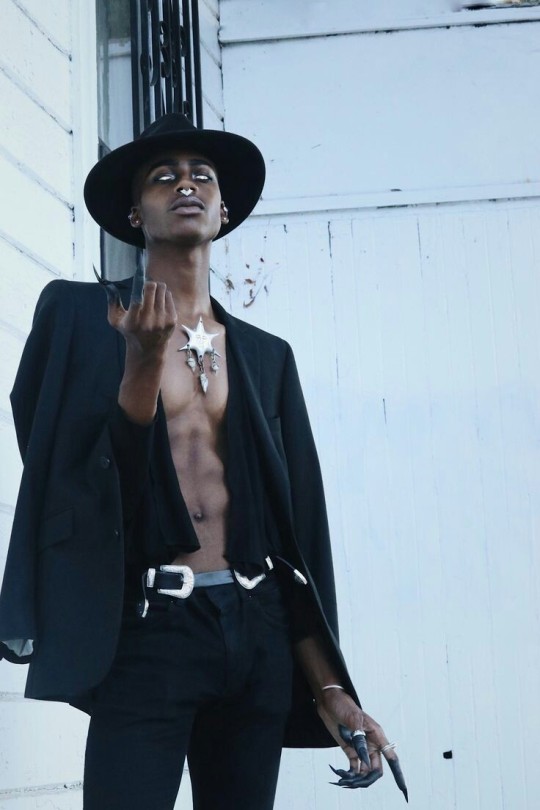

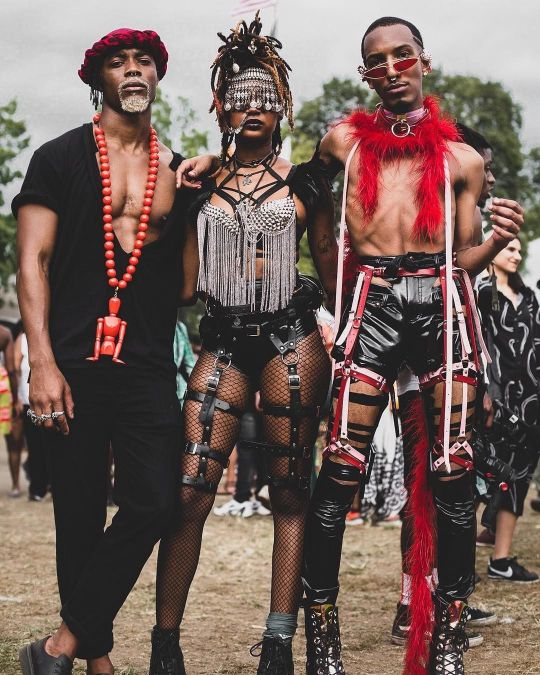

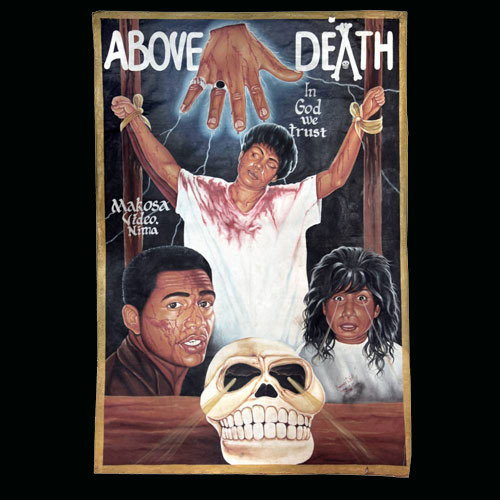



Marauders African AU Moodboard.
Something is brewing.
Image sources:
1. Adrian Patterson https://www.instagram.com/beingadp?igsh=MTFnOG1scjd0bTdhdA==
2. Fabrice Monteiro https://www.artsy.net/artwork/fabrice-monteiro-the-missing-link-joe-1
3. Have not yet found the original photo, but there was Pinterest upload: https://in.pinterest.com/pin/408349891216856527/
4. Theresa Fractale http://www.blackgeeksociety.com/socialpsychopathblrtheresa-fractale/2016/08/26
5. And 6. http://mondoexploito.com/?p=7602
7.killstar https://www.instagram.com/p/BVEyPYdj313/?igsh=MTliM3I3MHFheTkxOA==
8. Simon Chetrit, Afro Punk Festival 2018, Repeller https://repeller.com/afropunk-festival-street-style-2018/?utm_source=newsletter&utm_medium=email&utm_campaign=mr_owned
Also: there should definitely be a school of magic in Timbuktu. And Benin. And Egypt. Why only Uagadou?
There must have been some type of shitty after taste from imperialism and lot of the Ancient schools just decided not to be involved with the Western Wizarding world.
I bet the Western magic is so different from African magic that the Western schools of witchcraft don’t even recognize the African school of magic as real magic. And the magic would be different in different parts of Africa.
in West Africa There would be a lot more nature bound rituals, music and collaboration with the ancestral spirits and communal magic. The spells would involve long incantations based in ancient African languages done in sacred ritual places and there would be less emphasis on face to face duels and other brutal methods of the whites. There would be no use of fragile magic wands. The magic would be tied to an objects like a pot filled with magical items hidden in ground and the object would be dug out and used to perform powerful magic in secret gatherings. The magic would be communal and would depend to be produced as a group and not an individual effort. There would also be significantly more animagi and no requirement to be registered, much to the annoyance of the Europeans.
So Uagadou was probably just the most European complying and adopted more of their techniques and was included in the list of officially recognized schools as they fit the European idea of what magic is and what a school of magic is.
Just my thinking. I would love someone to develop this idea. I’m feeling sort of not allowed to go very far with this on my own as I’m not African and am very bloody white myself. I have however lived in Ghana for a decade and married to Ghanian for 16 years and I feel pretty integrated and maybe this is why I feel so drawn to the idea of African schools of witchcraft. Maybe as something my kids could relate to.
14 notes
·
View notes
Text
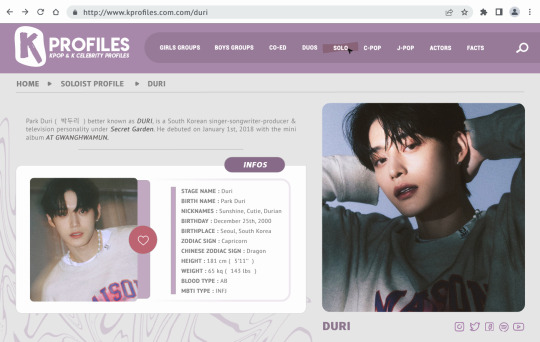
HOME → SOLO → DURI.
PROFILE:
STAGE NAME: Duri. BIRTH NAME: Park Duri (박두리). BIRTHDAY: December 25th, 2000. ZODIAC SIGN: Capricorn. CHINESE ZODIAC SIGN: Dragon. HEIGHT: 181cm (5'11''). WEIGHT: 65kg (145 lbs). BLOOD TYPE: AB. MBTI TYPE: INFJ. REPRESENTATIVE EMOJI: 🐶. INSTAGRAM: @\duri FANDOM NAME: durian REPRESENTATIVE COLOR: lavender (#E6E6FA)
Duri Facts:
He is from Itaewon-dong, Yongsan-du, Seoul, South Korea.
Duri has stated that he was born on December 25th, 2000 at 9:48pm. He referred to himself as a "late Christmas gift."
While growing up, Duri used to attend a vocal and music academy. He says he chose to do this instead of cram school because it interested him more.
In school, he always used to be the class representative every single year because he was friends with everyone. [Confirmed by Friend on Twitter]
He's an only child and was raised by his Uncle & Aunt.
Education: Seoul School of Performing Arts (SOPA).
He has level 10 certificates in Violin, Piano, and Guitar.
He has level 5 certificates in English and Japanese.
Duri said he learned English and Japanese on his own for a long while and completed his testing fluency before the end of high school. He says he did this because he wanted to learn, but also because he wanted to better help foreigners in Itaewon while growing up.
Duri is certified in being a vocal trainer, which he gained as a teenager.
Before debut, Duri was a Youtuber under the name "Duri's Record Shop." In October of 2017, he went semi-viral with a cover of Whitney Houston's "I Will Always Love You"
He signed with Secret Garden in November of 2017.
He said that after he went viral, tons of Entertainment companies reached out to him, including Everlast Entertainment. However, he ultimately chose Secret Garden because they wanted to debut him soon.
Duri states that he didn't really train, besides for a few different classes. Instead, he immediately started the debut process upon entering Secret Garden.
Duri stated that when he was fourteen, he won a talent show and was approached by a bunch of different scouts. However, he didn't think they were real and turned them down.
He always dreamed of being an idol.
Duri is known for being on variety shows and being a television personality. He's been main cast in Idol Dictation Contest, New World, and Youn's Stay. He won the award, Best New Male Entertainer, at the 1st Blue Dragon Series Awards.
He's been the brand ambassador for Ghana Chocolate, Coca-Cola, and Boy De Chanel in the past.
He's a really big cook, he said he learned when he was younger, and he tries to cook as much as possible.
Has an alcohol allergy. He said he's unable to have anything containing alcohol or anything that's fermented because of his allergy.
He doesn’t have a driver’s license and says he doesn’t want one. He tends to walk or take public transport.
Known for his powerful voice and ability to portray a lot of emotions in his singing.
He can sing So Chan Whee’s “Tears” in the original female key.
Duri stated that his biggest inspirations are Whitney Houston, Céline Dion, Kelly Clarkson, Beyoncé, and various ballad singers.
Duri likes to do a lot of reading, he can often be seen reading while waiting around. He has a whole collection of books and has said at fan signs that he can’t pick a favorite book.
He says his special skills include singing high notes, singing, doing girl group dances, cooking, playing guitar, violin, and piano, English, Japanese, and being cute.
He said that he likes playing "cozy" video games and those are the only type of games that he plays.
His favorite colors are lavender and pink.
His representative emoji is 🐶.
Duri's favorite animal is dogs.
His favorite foods include pasta, anything chocolate, and hotteok.
He says he owns a collection of books, mugs, legos he built, and plushies.
#thefourprompt1#the credit for the kprofile template goes to kapheira on deviantart#╰ ♡ filed under: task.
9 notes
·
View notes
Text
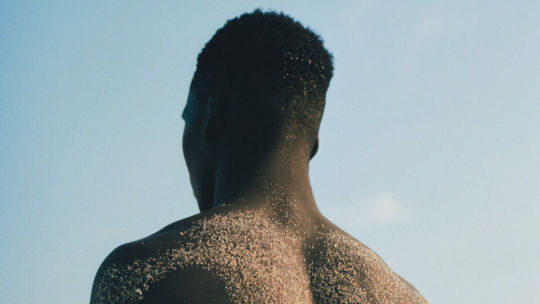
Coming of Age
Rolling waves, sandy beaches and lush green palms. This is what Austria-based photographer Eric Asamoah (b. 1999) found when he arrived in the cities of Accra and Kumasi in Ghana. Later, whilst exploring his parents’ country of origin, Asamoah would meet a new generation of young men. They would rest, read and make music amidst the country’s picturesque landscapes. Soon, these adolescents would become the subject of Asamoah’s lens, resulting in two projects: The Day After Tomorrow and, most recently, Forever Lasts Until It Ends, which was made in and around Tongo, the capital of Ghana’s Talensi District.

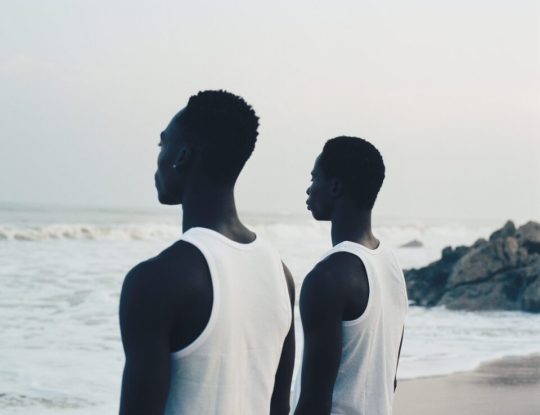


#eric asamoah#photographer#austria-based photographer#accra#kumasi#ghana#young african men#the day after tomorrow#forever lasts until it ends#tongo#talensi district
2 notes
·
View notes
Text




#update#moliy#afrobeats#afrofusion#music#wondergang#wondergirl#ghana girl#ghana#original character#nyc#once upon a time#glow up#curators on tumblr#great artist#musician#new music#songs#tunes#good music#music video#photography#photoshoot#my photos#photooftheday
11 notes
·
View notes
Text
All modern music descends from blues and jazz, blues and jazz descends from spirituals and field hollers that enslaved people brought over from West Africa, of the regions represented- the largest nation represented is Ghana. It would not be inaccurate to say that all modern music very specifically comes from Indigenous Ghanan tribes
This needs to be stated because many music historians have no problem acknowledging that all modern music descends from the music of enslaved people but they'll argue that actually those enslaved people acquired "soul" from the Gospel music of their white owners. It's credit, sure, but in the most back-handedly racist kind of way.
The reality is that both the banjo and the guitar- instruments that are the bedrock of popular sound- are from Africa: the banjo coming from Ghana and the guitar coming from several different places in North Africa. The call-and-response style popular in Roots Music like folk, country/western, jazz, and blues is typical of tribal music in Ghana- not the traditional music of Western Europe. And the Pentatonic scale- without which you do not have blues, rock, or metal- was considered Satanic by the Catholic Church for the express reason that it is popular in Africa- debatably originating in Ethiopia.
If we actually want to see black musicians credited the way they deserve for their contributions: we have to acknowledge that modern music not only comes from black culture but- very specifically- from Africa. Otherwise, white music historians will just find a way to weasel a "but actually it comes from white people" in there somewhere.
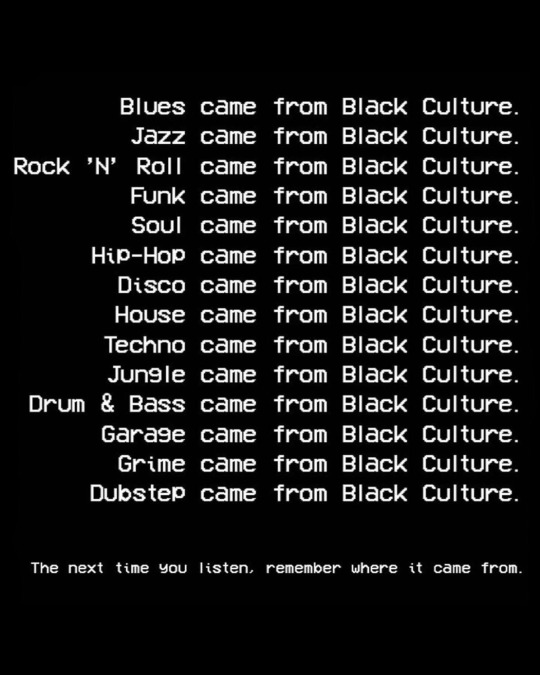
We owe it all to them.
62K notes
·
View notes
Text
Kay Bryn x OlivetheBoy: Are These Two Cooking Up a Hit in London?
New Post has been published on https://plugzafrica.com/kay-bryn-x-olivetheboy-are-these-two-cooking-up-a-hit-in-london/
Kay Bryn x OlivetheBoy: Are These Two Cooking Up a Hit in London?

UK-based Afrobeat sensation Kay Bryn has sparked excitement among fans after being spotted in a recording session with Ghanaian hitmaker OlivetheBoy on Sunday, March 9, 2025, in London. The link-up, which took place over the weekend, has fueled speculation about a potential collaboration between the two rising stars.
OlivetheBoy, known for his chart-topping hits and infectious melodies, was in London for the Ghana Independence Day Bash at Indigo O2, an annual celebration hosted by Alordia Promotions, Akwaaba UK, and WestCoast. While in town, he linked up with Kay Bryn, a fast-rising force in the Afrobeat and Afropop scene, who recently bagged the UK-Based Afrobeat/Afropop Artist of the Year award at the 2024 Ghana Music Awards UK.
Watch exclusive visuals of their studio linkup below:
Although details of the session remain under wraps, fans are already speculating on what could be an explosive Afro-fusion track. Given Kay Bryn’s signature smooth vocal delivery and OlivetheBoy’s knack for creating viral anthems, a collaboration between the two artists is poised to make waves across the Afrobeat landscape.
Neither artist has officially confirmed a joint project yet, but with both making significant strides in their respective careers, the possibility of a collaboration is an exciting prospect for music lovers.
Stay tuned for updates on this developing story.
Follow Kay Byn on social media for updates:
Instagram: iam_kaybryn
Twitter: @iamkaybryn
Facebook: Kay Bryn
About Kay Bryn
Kay Bryn is a dynamic Afrobeat and Afropop artist known for his distinctive sound and powerful stage presence. Based in the UK, he is rapidly gaining recognition for his fresh approach to the genres, blending traditional African rhythms with modern pop elements. His debut album, Far From Original, highlights his versatility and commitment to creating timeless music.
Youtube:
youtube
Audiomack:
Spotify:
0 notes
Text
Sweet Stories 2 Reimagined: An Evolution in Sound and Soul For Jay J. Ra Music is a journey, and for this artist, that journey has taken an exciting new turn with Sweet Stories 2. Originally released in 2022 under the name D.bé Jayri, Sweet Stories was a reggae-infused ode to love and compassion, filmed in Accra, Ghana. Sweet Stories 2 (Soulful Solo Version) is the official solo version of Sweet Stories 2 featuring African Child. Now, with a fresh Afrobeat arrangement and a collaboration with Ghanaian artist African Child, Sweet Stories 2 breathes new life into the original message while expanding its reach. This project is more than just a genre shift—it represents artistic evolution, cross-cultural collaboration, and a deeper exploration of musical storytelling. From facing unexpected delays in production to embracing new vocal styles, the path to Sweet Stories 2 was one of persistence and growth. In this interview, we dive into the creative process, the challenges faced, and the emotional depth behind this release. Join us as we explore how this artist blends R&B, pop, gospel, and Afrobeat to craft a sound that is both personal and universal. Listen to Sweet Stories 2 https://open.spotify.com/album/7Lz5U8YuYM82a0nHJqTr7b?si=tVGUtdGjRAiXycAYlNunsQ https://open.spotify.com/album/4w5Za2EGm1qB94AsYVT0ic?si=_Wsl9upkRT69uqIupI3yoQ Follow Jay J. Ra on Facebook Spotify Bandcamp Youtube Twitter Instagram Tiktok "Sweet Stories 2" suggests a continuation of narrative themes. How does this release build upon or differ from the first installment?: I wrote the original Sweet Stories to a reggae performance style, conveying a message of love and compassion, in slow tempo. Sweet Stories was released in 2022, under my old artist name, D.bé Jayri, and I shot the music video for it in Accra, Ghana that very same year. The music video is available on YouTube. A radio host and friend of mine that I had met in Ghana, suggested to me last year, that should I put together a record that will gain the attention of the African music market, more specifically, a Ghanaian audience and get them acquainted with my artistry. Thus, my friend, the radio host, got the original Sweet Stories song re-done into an upbeat Afro-beat style arrangement and also suggested that I collaborate with a Ghanaian artist. So, the differences between the original and Sweet stories 2 are the genres, the tempo and the opportunity to collaborate with a fellow artist from Ghana, African Child, (on the collaborative version). However, the lyrics (in most cases) and theme remained the same. How has your approach to storytelling through music evolved between the first and second chapters?: As I said before, the theme and most of the lyrics remained the same. However, I saw my art of story-telling evolved in Sweet Stories 2 with the influence of direct Afro-beat arrangements and collaborating with a fellow artist. I was able to vocally express myself and my style of singing with joy to music directly coming from the motherland, the African continent. When I first heard the instrumental and re-arrangement of Sweet Stories, I immediately knew the lyrics and emotions would be expressed through the styles of R&B and Afro-beat, something I am fairly new to as an artist. Were there any specific life experiences or emotional moments that influenced the stories in this release?: I have been into several relationships in the past to know the importance of companionship, even though some where very brief, however, this song was written based on my general experience of love affection and on the idea of what a lasting companionship could be. The title implies a certain tenderness or nostalgia. What kind of emotional landscape were you aiming to create?: The emotional landscape that I try to express is to encourage us to just take the time to love and appreciate and enjoy your significant other, and it may not even be your significant other only, but your loved ones
and others as well, because life is short and uncertain and the most we can do, most of the time, is to show love to everyone. [caption id="attachment_59015" align="alignnone" width="1126"] because life is short and uncertain and the most we can do, most of the time, is to show love to everyone.[/caption] Could you share a particularly meaningful moment or story from the creation of this project?: After I recorded Sweet Stories 2, here in Canada, I sent it over to my radio host friend in Ghana. He then gave over the track to a studio engineer in Kumasi, Ghana, to mix and master it, and it is that very same studio where African Child, the featured artist on the collaborative version, recorded his part. My friend and I planned to release the song in November 2024, so we could promote and push the song during the upcoming holiday season, then. However, for some reason, the studio engineer sat on the record for months without doing any work on it. I got worried and a bit frustrated and asked that the project to be taken from that studio engineer and be given to another. The track was mixed by another studio engineer in Ghana called Quab Sea and I was able to release the record publicly on February 1st, 2025. Sweet Stories 2 (Soulful Solo Version) was mixed and mastered by K.R. Moore, my studio engineer here in Canada. Even in face of uncertainly, I still believed in this project, and it turned out to be amazing. How do you balance maintaining your signature sound while pushing your artistic boundaries in this new release?: My style of singing is mostly Pop/R&B/Gospel, (for an industry that is fanatic to categories sounds, but I don't). I saw myself blending all those genres to communicate well with the essence of the afrobeat instrumental on the record. I found myself singing R&B but consciously and carefully tried to tailor it to a wider African audience. So we could call the track an Afro-beat R&B/Soul and Pop record? I suppose so. What musical elements or production choices help convey the "sweetness" in these stories?: Well, it depends on what your perception of "sweetness" is. However, I believe what made this track "sweet" was that I decided to soulfully re-do the vocals and added a little more vocal riffs and runs, well, to make the track more smoothe and Jazzy, a contrast to Sweet Stories 2 (featuring African Child) which sounds more Pop, commercial and edgy. Did you collaborate with any new artists or producers for "Sweet Stories 2"? How did these collaborations shape the final sound?: Well yes. With help from my radio host friend, I was able to collaborate with Dan Bassey of Ghana, who is the music producer of both Sweet Stories 2 (Soulful Solo Version) and Sweet Stoires 2, and as mentioned before, also collaborated with African Child, a fellow Ghanaian artist, who is the featured artist on Sweet Stories 2. The communal efforts of all us as artists, producer and studio engineer, had made the sounds of both tracks phenomenal. Even though each record have a slightly different sound and feel to them, both however, have the same larger than life African musical elements that gives them an epic sound. https://open.spotify.com/artist/19dKiDsJ2XxPS4n1Bxqcch?si=pWW_X5CiSWqWAJmlyy1Kfw Looking back at both "Sweet Stories" projects, what have you learned about yourself as an artist?: This project made me see how far I have come and grown as an artist. For years I have written my own songs, but this project has proven to me that I can be a more versatile and open minded writer for music, and also for other artforms such as film, television books and poetry. Can listeners expect certain themes or motifs to carry through both releases? How do they connect?: Love, affection and adoration, those are the themes and motives behind the song, and all are imter-correlated. What's next for you after "Sweet Stories 2"? Will there be a third chapter in this musical narrative?: I will leave an open mind to this idea: there maybe another chapter to Sweet Stories, or I may just cap it at number 2.
..who knows..let us see which direction the universe takes us.
#Interviews#JayJ.Ra#JayJ.Ra discography#JayJ.Ra music#JayJ.Ra musicalartist#JayJ.Ra musicalband#JayJ.Ra newsingle#JayJ.Ra profile#JayJ.Ra singer#JayJ.Ra songs#JayJ.Ra videos#JayJ.RadropsSweetStories2ftAfricanChild#JayJ.RareleasesSweetStories2ftAfricanChild#JayJ.RashareslatestsingleSweetStories2ftAfricanChild#JayJ.RaSweetStories2ftAfricanChild#JayJ.RaunveilsnewmusictitledSweetStories2ftAfricanChild#JayJ.RawithSweetStories2ftAfricanChild#SweetStories2ftAfricanChild#SweetStories2ftAfricanChildalbumbyJayJ.Ra#SweetStories2ftAfricanChildbyJayJ.Ra#SweetStories2ftAfricanChildfromJayJ.Ra#SweetStories2ftAfricanChildJayJ.Ra
1 note
·
View note
Text
Discover Ghana: 10 Breathtaking Places You Must Visit in Ghana! | Life Travel
https://expedia.com/affiliate/kBwO7hq
10 Most Beautiful Places to Visit in Ghana
🌍✨ Come along on an unforgettable journey through Ghana as we explore the 10 Most Beautiful Places to Visit! From breathtaking natural landscapes to vibrant cultural hubs, Ghana is a hidden gem in West Africa that’s just waiting to be discovered.
In this video, we’ll take you to stunning beaches, historic castles, lush national parks, and charming towns that showcase the rich heritage and beauty of this incredible country. Whether you're planning your next adventure or simply looking for travel inspiration, this video is your ultimate guide to the must-see spots in Ghana!
👉 Places Covered:
Kakum National Park
Cape Coast Castle
Busua Beach
Lake Volta
Aburi Botanical Gardens
Mole National Park
Elmina Castle
Nzulezo (the Water Village)
Boti Falls
Accra’s Arts Center
Don't forget to like, subscribe, and hit the bell icon for more amazing travel content! Share your favorite place in Ghana in the comments below!
📸 Follow us on Social Media:
https://www.tiktok.com/@lifetrevels @LifeTrevels
https://www.linkedin.com/company/lifetrevels/
0 notes
Text
Gharat Ganpati Movie

Introduction:
The Marathi movie Gharat Ganpati depicts how people of a particular village, celebrate the festival of Ganesh Chaturthi. which has a rather good relation. The movie is directed by Pradeep Sharma and produced by Mohan Depth starring Nikhil Mahajan, Amrita Subhash, and Sandeep Kulkarni in a tremendous cast. The desire to focus on interpreting the festival in the characters’ lives as the emotional and cultural need is achieved. It is to be launched on 26th of July 2024 and the movie seems to be entertaining while being considerate of the etiquette of the area.
Story:
The Mishra family itself mostly celebrates the Ganesh Chaturthi festival and hence the story in the “Ghar-Ghana” Family Preparations revolves around the Mishra family. Community engagement and increasing individual issues are the features of the stories before and after the festival. The movie is a comedy about a family and a community embracing and celebrating a tradition. and the sometimes strained interpersonal dynamics that come with the occasions.
Positives:
Authentic Representation: The film has implemented such an incredible passion and essence of Ganesh Chaturthi on a successful note. Such details as the depiction of the customs and rituals performance gives another dimension of realism to the film.
Good Performances: The actors have done well in their performances. The organizer is played by Nicole Mahajan and we can see that she is very charming and bestowed with great acting skills. Sandeep Kulkarni plays his character with much more subdued. With the character of ‘Amrita Subhash’ the character has more depth added to it.
Eye-catching: Bright and brightly shaped picture. Displaying happy and active images brings the viewers to the environment of the festival atmosphere. It perfectly captures the lively and lively mood…
Soundtrack: The compositions made by Rohan-Rohan for the movie’s soundtrack bring a wonderful addition to the movie’s storyline. The combination of classic and contemporary songs creates the atmosphere and the enjoyment of the movie.
Negatives:
Pacing Problems: It is undeniable though that there are some dull sequences in the movie. Above all, it can be seen in the middle which is too weak in character development. This means that the story can become less engaging and boring for the viewer of the media.
Predictable Plot: While watching the movie some social issues that are relevant today are depicted, at the same time the movie has a very typical storyline. There are no surprises in the course of the dispute or the resolution of the same. All of them, of course, move in the original direction.
Character Depth: Any additional growth for this show will make some characters better. It has less effect on the story as you do not experience a profusion of supporting characters.
Technical Aspects:
Direction: Far from neat, Pradeep Sharma’s direction is efficient enough. It also adds the feel of the actual festival into the film successfully. However, they make it difficult to focus on the audience and set the pace of the show.
Cinematography: Specifically, Ankit Shah has done very good work in the experimentation of cinematography skills. Gorgeous festival pictures depict the large and small parts of the festival. Let those pictures look lovely.
Editing: All in all, there are many aspects in which Meera Singh’s work is fairly well-rounded. However, the issue of pacing remains the film’s flaw that cannot be addressed. It is better to trim some sequences for the births of the others.
Sound Design: The fun tone of the movie is well complemented by its soundtrack. Sometimes traditional music is played more often than required and can become a monotonous tune but the background score has an emotional feel to it.
Performance:
Nikhil Mahajan: As one of the organizers of the event and the major responsible for planning such event. In particular, this actor was able to demonstrate an outstanding charm and stage presence. It also brings a more realistic and realistic feeling to the movie because of his acting.
Amrit Subhash: She adds emotion to the story by sensitively portraying her characters and making realistic portrayals hence producing robust performance.
This adds more depth to the movie and the portrayal by Sandeep Kulkarni who I believe has given his character more depth than the other actors because of the nature of the character.
Conclusion:
The great movie ‘Gharat Ganapati’ will serve well in presenting the time and feeling of Ganesha Chaturthi. include, but not limited to the value of education, health, friendship, and family and community ties. The main benefit of this festival is the animation. Of course, the film has a very good performance and very attractive appearance By the same token, the film lacks a very strong storyline. : low plot pace and screen characters.
In particular, for those who have something to do with Marathi cinema and cultural events, “Ghar-Ghana” is quite a charming show. Although it may not be a new story Saddam, bin Laden, and other evil souls have sowed seeds of violence and hatred in different parts of the world. But it is also a tribute to the exquisite traditions of Ganesha Chaturthi which concludes by immolating Ganesha’s life-like statue and symbolically bidding adieu to him. Offers fun and information about a favorite holiday.
0 notes
Text
NFR Reviews #7: The Endless Summer
Released 1966 / Inducted 2002

Surfing momentarily took over pop culture in the first half of the 1960s. Post-WWII experimentation with new materials like resin, fiberglass, and later foam made more maneuverable, easier-to-produce surfboards. Media production followed suit. The music charts featured surf-rock artists like the Beach Boys and Dick Dale, while movies like 1959’s Gidget, 1961’s Elvis vehicle Blue Hawaii, and several following beach party movies used the sport as a selling point. It wasn't difficult to see the appeal: a combination of idyllic beach scenes, a sense of freedom, and a little bit of thrill and danger.
Despite all that, director Bruce Brown struggled to find distributors for this low-budget movie due to perceived lack of mainstream appeal. It was a hit on its first screenings in Wichita, Kansas, but distributors weren’t sure about it until after a successful run at Kip’s Bay Theater in New York City. It set itself apart from other films cashing in on the trend. Other surf films were more commercialized and focused more on hedonism and romance subplots than the athleticism of the sport itself, its creators often having little direct surfing experience. Many early-60s beach party movies leaned towards clean-cut characters with parent-generation-approved behaviors and values despite a lack of onscreen adult supervision, starring teen idols like Fabian and Frankie Avalon. This one had a niche target audience of other surfers, to be exhibited at surf clubs, placing it in the subgenre of “pure” surf movies. Other surf media portrayed California as an object of escapist desire filled with bright colors and suntans; this one has the state as an overcrowded locale with an inconvenient winter season. This sets up the central concept: surfers Mike Hynson and Robert August leave California to travel around the world, following the summer season through Africa, Australia, and the Pacific Islands to find the perfect wave.
The Endless Summer does share one quality with all the surf exploitation movies and music: its intention to be seen as young and hip. Thanks to the postwar economy and baby boom, the mid-60s had an abundance of young people with disposable income. It gained traction in the mainstream despite its niche roots, which the director attributed to a desire for innocence and escapism during the Vietnam era. Another big factor is how the movie makes you feel like you’re an accepted member of a cool, trendy club. Bruce Brown’s narration offers a fresh distinction from the average documentary narrator. He positions himself as the viewer’s buddy and not a teacher or authority figure by peppering the script with jokes. He refers to himself by saying things like “he’s the only surfer I’ve ever seen do this,” aiming for the specificity and relatability of his personal experiences instead of having the narrator be a detached, objective presence. Due to its origin as silent footage screened in clubs with Brown adding live commentary, the official script and music recordings were added after the fact. He’s the sole voice heard through the majority of the film’s runtime. Instead of hearing either the surfers or natives speaking on camera, Brown often-jokingly recreates interactions and voice impressions in a similar manner to retelling old stories with a friend. The repetition of “You should’ve been here yesterday” in the Australia section, referring to how the best waves always happen the day before a surfer arrives, gives the audience the feeling of being let in on an inside joke.
As soon as the two surfers arrive in Senegal, waves breaking outside their hotel are accompanied with a narrative of unconquered wilderness, complete with waves no surfer had ever ridden or perhaps even seen. In the Ghana section, comedy is mined from the locals being clueless about surfing. There’s jokes about Africans potentially attacking over violations of unknown religious taboos or spearing the surfers, too. The film claims the American surfers were the ones to introduce surfing to the area and no one else had seen anything like it. The film later admits the fishermen's canoes weren’t so different, albeit intended more as practical tools for work than a sport. Surfing developed in Polynesia, and was introduced to the US through Hawaii. It held major spiritual significance, and the best surfing spots were reserved for royalty. However, similar wave-riding practices developed independently throughout Africa, with one account dating back to the 1640s in what’s now Ghana. They used canoes, yes, but also 12-foot longboards and smaller boards of 3 to 5 feet in length. Onscreen, the surfers have little issue sharing their knowledge with the kids and appear to get along with them. However, the additional in-film framing and narration portrays them as an “other.” The narrative is of Americans who have the means and leisure time to travel the world versus some countries they visited whose ways of life that haven’t changed in millennia and are more tied to daily labor such as fishing. Many elements in modern surf culture did originate in Polynesia–equipment innovations like the long, narrow olo board, surf forecasting, and techniques of trimming across the wave face being some of them. However, the concept of using a board to ride waves for fun and sport developed across most warm-water coastal cultures, including Ghana.
The perfect surfing spot contains a finite amount of space. In the mid-1960s, Surfer magazine began keeping some spots secret so tourist overflow wouldn’t ruin the experience. Author Matt Warshaw suggested journeys to far-flung locations were less about new discoveries and more about getting away from crowds. The Endless Summer team found the perfect wave in South Africa, a country they previously noted as having long stretches of uninhabited space. Like many subcultures, surfing enthusiasts formed in-groups and out-groups. Endless Summer takes steps to define its own identity through who it wants audiences to identify with and who is used as a point of comparison. Its breezy sense of humor twists the traditional documentary format away from “narrator as objective teacher” into “friends joking around.” It captured a youth culture of the time that was distinct from their parents’ mores in a more naturalistic way than the commercialized offerings of big studios. Unfortunately, it also makes comparisons by flattening other countries into unexplored wilderness areas filled with primitive people. The movie’s methods of identity-forming are strongest when the subculture defines itself as who they are, not who they aren’t. A film lacks the limited space of real surf spots, and this one found a wide audience outside niche surf clubs by making viewers feel like they’re included in the club, whether they've ever surfed themselves or not.
Sources
https://e-space.mmu.ac.uk/617596/1/Endless%20summer%201%20Nov%2004.pdf
https://e-space.mmu.ac.uk/617593/1/surf%20rhetoric%20in%20british%20magazines.pdf
https://lagunaartmuseum.org/exhibitions/surf-culture-the-art-history-of-surfing/
https://core.ac.uk/download/pdf/37438736.pdf
https://www.surfertoday.com/surfing/things-you-didnt-know-about-the-endless-summer
https://www.surfer.com/news/africans-surfed-long-before-bruce-brown-showed-up
https://www.fairobserver.com/history/how-ancient-polynesians-conquered-the-pacific-on-their-surfboards/#
https://www.pbssocal.org/shows/lost-la/clip/the-endless-summer-defined-surf-culture-on-its-own-terms
https://www.theinertia.com/surf/where-was-surfing-actually-born-a-look-at-the-origins-of-wave-riding/
https://www.surfertoday.com/surfing/hawaiian-words-every-surfer-should-know
https://en.wikipedia.org/wiki/The_Endless_Summer (Tumblr link limit strikes again)
1 note
·
View note